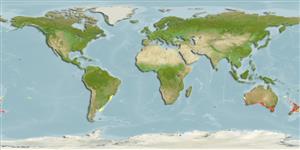Actinopterygii (ray-finned fishes) >
Perciformes (Perch-likes) >
Cheilodactylidae (Morwongs)
Etymology: Nemadactylus: Greek, nema, -atos = filament + Greek, daktylos = finger (Ref. 45335).
Environment / Climate / Range
Ecology
Marine; demersal; depth range 22 - 450 m (Ref. 58489), usually 100 - 250 m (Ref. 3243). Subtropical, preferred 27°C (Ref. 107945); 27°S - 48°S, 62°W - 176°W
Indo-Pacific: St. Paul and Amsterdam islands in the Indian Ocean, southern Australia, including Tasmania, and New Zealand. Southwest Atlantic: southern South America.
Length at first maturity / Size / Weight / Age
Maturity: Lm ?, range 25 - 35 cm
Max length : 70.0 cm TL male/unsexed; (Ref. 9563); common length : 35.0 cm TL male/unsexed; (Ref. 3243); max. published weight: 2.9 kg (Ref. 6390); max. reported age: 50 years (Ref. 26998)
Adults demersal on the continental shelf and upper slope (Ref. 9563) to depths of 450 m (Ref. 33616). Juveniles tend to live near shallow reefs (Ref. 6390). Postlarvae inhabit offshore waters and are found in surface waters at night (Ref. 9072). Average weight is 1800 g. Feed on polychaete worms, crustaceans, mollusks and echinoderms (Ref. 28626). Flesh is quite good eating. Often sold as tiki fillets.
Jackass morwong have an extended pelagic postlarval stage (Ref. 6390). Research in New Zealand has shown that metamorphosis to the juvenile stage occurs between 9 and 12 months after hatching (Ref. 28625).
Kailola, P.J., M.J. Williams, P.C. Stewart, R.E. Reichelt, A. McNee and C. Grieve, 1993. Australian fisheries resources. Bureau of Resource Sciences, Canberra, Australia. 422 p. (Ref. 6390)
IUCN Red List Status (Ref. 115185)
CITES (Ref. 94142)
Not Evaluated
Threat to humans
Harmless
Human uses
Fisheries: commercial; gamefish: yes
Tools
Special reports
Download XML
Internet sources
Estimates of some properties based on models
Phylogenetic diversity index (Ref.
82805): PD
50 = 0.5078 [Uniqueness, from 0.5 = low to 2.0 = high].
Bayesian length-weight: a=0.01380 (0.01001 - 0.01903), b=3.01 (2.92 - 3.10), in cm Total Length, based on LWR estimates for this species (Ref.
93245).
Trophic Level (Ref.
69278): 3.4 ±0.42 se; Based on food items.
Resilience (Ref.
69278): Low, minimum population doubling time 4.5 - 14 years (K=0.1-0.28; tm=3-6; Fec=100,000; tmax=50).
Prior r = 0.31, 2 SD range = 0.13 - 0.74, log(r) = -1.17, SD log(r) = 0.43, Based on: 3 K, 3 tgen, 1 tmax, 2 Fec records
Vulnerability (Ref.
59153): Moderate to high vulnerability (50 of 100) .
